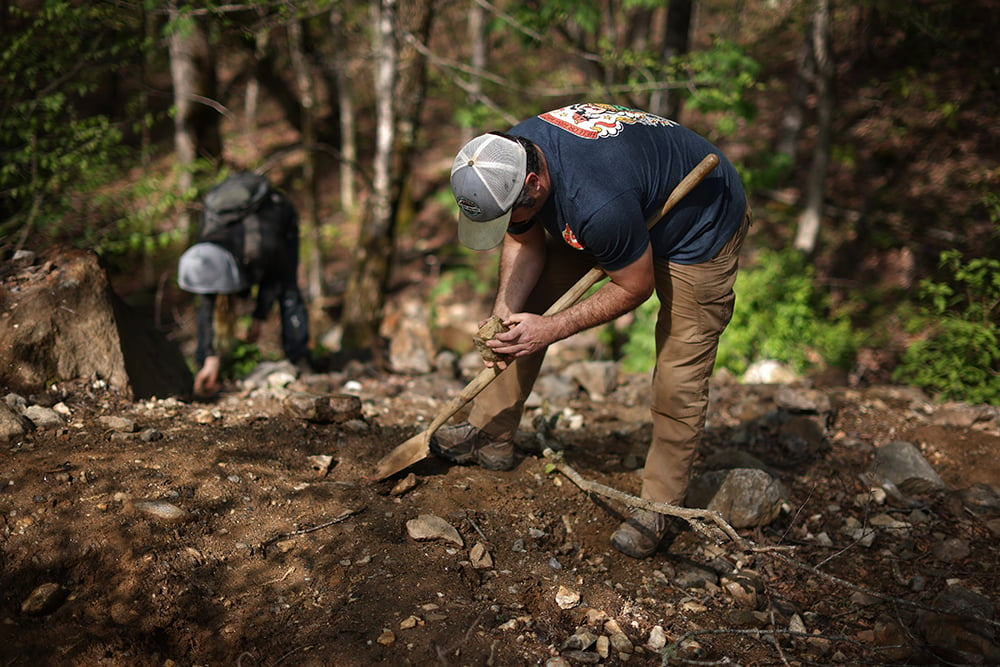The Emerald Rockhounds of North Carolina
The mines shut down a half-century ago, but the emeralds remain. In Mitchell County and beyond, North Carolina’s ragtag rockhounds still seek buried treasure

Early on a spring Sunday, the Appalachian foothills wear fog like lingerie. Out of the mist emerge street signs: Bear Wallow, Fox Run, Possum Trot. In Spruce Pine, a town of 2,000 about 50 miles northeast of Asheville, my phone directs me down ever more remote roads. Though mine is the only car in sight, I wait for minutes at a temporary stoplight, wheeled in to restrict traffic where Hurricane Helene washed away part of the road last September. When the lonely light changes, I creep uphill and around a bend, peering over a ledge of broken asphalt into the ravine where the road vanished.
Helene’s ghost lingers in the woods along the roadside creek. Fallen trees lie like tombs. A flooded house stands empty, blinds askew. Emerald Village, a tourist attraction of 12 historic commercial mines, looks abandoned. The road narrows and turns to gravel. The houses disappear, and the rutted track hardly qualifies as a road anymore. No-trespassing signs tattoo fences. At a powerline cut, I’m relieved for an area wide enough to turn around. This can’t be right. I’m off the edge of the map.
Travis Dove, the photographer for this story, emails me that he’ll be late because he went to the wrong place. “Me, too,” I reply. Our paths likely cross as I backtrack because, it turns out, this scrap of woods in the middle of nowhere is exactly where I’m supposed to be.
When I figure that out and jostle my way down the gully again, I get out of the car where the road becomes impassible. It’s migration season, and the warblers are making a racket. I follow the sound of voices. Finally, more than an hour late, I turn up at a camp that wouldn’t look out of place post-apocalypse.
I’ve found the rockhounds.

“We got everybody. People from all different viewpoints. We keep all that out of it and just dig rocks.” – Rick Jacquot
I traipse past a pond to meet Rick Jacquot, president of the Mountain Area Gem and Mineral Association. It doesn’t matter that I’m late—he’s forgotten I was coming. He convened this weekend event to clean up the mine area, and now, on Sunday morning, the campfire burns low, and the rockhounds are packing up.
Jacquot, 62, looms large, both physically and metaphorically, in this community; he’s run MAGMA from his home near Asheville for 25 years. He’s collected minerals since he was 8 and growing up in Maryland, and he’s built an adventure-studded resume since. He scuba dives in blackwater rivers. He’s salvaged shipwrecks. He’s found megalodon teeth and first-of-their-kind fossils, one of which—from a sirenian species—is now in the Smithsonian Museum. His main source of income is from selling trinitite, the rare glass formed from the test of the first atomic device in New Mexico in 1945; he says he has the largest collection in the world. Rockhounding, if Jacquot and this camp are any indication, attracts a diverse and motley bunch.
“We got everybody,” Jacquot says in a resonant drawl. “People from all different viewpoints. We keep all that out of it and just dig rocks.”
Jacquot derives some income from gem shows and the like, but he’s not in it for a payday. Few rockhounds are—although Terry Ledford, a former partner at the Crabtree Emerald Mine and a titan of local rockhounding, actually did hit it rich.
“He hit some emeralds in Hiddenite, North Carolina, and he ended up making a few million dollars,” Jacquot says. “He bought a house in a gated community and all this stuff.” He didn’t have long to enjoy it. Two years later, in 2014, he was digging in Hiddenite—an Alexander County town named for a type of spodumene emerald found only there—when a rock wall caved in and killed him. He was 56.
Most rockhounds are after something simpler, something that speaks to humanity’s primal nature. “It’s nice out here, sitting around the campfire instead of watching TV,” Jacquot says. Nearby, another rockhound, bent over the banks of a creek, says she’s out here to get her “hunter-gatherer fix.”

Emerald Village is a Mitchell County tourist attraction with 12 mineral mines—including the century-old Bon Ami Mine
Hunt rocks, and you end up finding a community. MAGMA hosts gem shows, cleanup weekends like this one, and digs. Everyone camping at the mine talks of camaraderie and the universal willingness to lend a hand. It’s a big part of what keeps them coming back.
“We have a lot of fun with each other,” says David Hotelling, 73, who spent the rainy weekend camped out in the bed of his pickup. Most everyone here has MacGyvered their vans and trucks into mobile homes for the weekend. “We sit around and tell stories—some of them you don’t want to tell during the day.”
Rockhounding, one senses, is the domain of old-timers. It takes patience and perseverance—a willingness to scour patches of innocuous ground and pick up a hundred rocks before you find the kind you’re looking for. Some of the rockhounds here learned their skills from Appalachian mountain men, forged by this land as much as the minerals they hunted. They knew, based on generations of experience, where to go and what to look for. Now, MAGMA members are passing away. At its peak, the club had about 3,500 members. Today, it has about 800. The Southern Appalachian Mineral Society, based in Asheville, died during COVID.
“Kids today don’t do much,” Jacquot says. “They’re on the phone.”
In 1973, the North Carolina legislature adopted the emerald as the state’s official gemstone—a sound choice, as North Carolina is the only place in North America with significant emerald deposits. It’s yielded both the continent’s largest emerald crystal—1,438 carats—and its most expensive cut emerald, a 13.14-carat stunner valued at $100,000. At Crabtree mine on the first weekend in May, a band of avid gem and mineral aficionados has convened to search for that green glimmer.
Wind your way through southern Appalachia, and it won’t be long before you pass a dilapidated gem-mining attraction. Pay 20 bucks for a bucket of sand and sift for gems shipped in from Brazil. The Crabtree mine is not that. No signs advertise it, and no one would pass it by chance anyway. To find it, you have to know where you’re going. Even then, as I found out, it can be tricky.
Gem and mineral hunters call themselves rockhounds, and they’re a breed that’s thrived in North Carolina—by necessity or by choice—for centuries. Aside from emeralds, the state boasts gold, diamond, garnet, ruby, sapphire, aquamarine, golden beryl, amethyst, citrine, quartz, and more. All are products of Appalachia’s rough-and-tumble geologic history.
At first, gemstones were a pretty byproduct of gold mining. In 1799, after a 12-year-old in Cabarrus County stumbled across a 17-pound gold nugget, the nation’s first gold rush was on. At its height, as many as 600 gold mines operated in the state. Mecklenburg County was home to the sizeable Rudisill Lode, and the area’s gold deposits are why a branch of the U.S. Mint resided in Charlotte until 1861. In the 1850s, the California gold rush lured many of North Carolina’s experienced miners west. In their wake, a spate of mines tried, with varying success, to capitalize on the state’s other mineral wealth.
The Crabtree mine opened in Mitchell County in 1894, and New York’s Tiffany & Company mined it from 1895 until 1900. A handful of companies operated the mine on and off until 1987. Then it sat idle. Water filled in the shaft and mine, which extends more than 200 feet underground. Today, this long-ago source of Manhattan glitz looks like any other pond but for the rusted steam winch on its banks.
The whole of Mitchell County tells a story of decline. Minerals made Spruce Pine. Thanks to the Feldspar Company, Spruce Mine Mica, and other mining concerns, strategically located along the Clinchfield Railroad, the town became a commercial and cultural hub, the largest in the county. Mining still provides the most jobs and income for Mitchell, Avery, and Yancey counties. The high-purity quartz in Spruce Pine is a key component of semiconductors, and the town is the sole supplier of sand to Augusta National Golf Club. But a shift away from rail transport has reversed the fortunes of this “Mineral City of the World.”
The town now bets on tourism, an effort hampered by Helene, which devastated this area. Meanwhile, the rockhounds cultivate young blood. Jacquot hopes to get the mineral society in Asheville back on its feet. Several at the weekend campout are in their 40s.
One is Steve Kovalcik, an Asheville firefighter. He and his wife started panning for gold to liven up their hikes, and they started turning up garnets. “That led us into more research,” he says, “and that’s when we were like, ‘Holy shit.’” They now make jewelry with their finds and sell it at gem shows and brewery pop-ups.
For the Kovalciks, part of the appeal is traveling the Southeast in their tiny, stick-shift camper van and hanging out with the old hands. Young guys, Kovalcik says, tend to hoard their spots, like it’s a competition. “The older generation will give you everything you can take, knowledge-wise,” he says. “A lot of these guys have been at it for a lifetime.”
One of the first things Jacquot did when I turned up was to give me a chunk of pegmatite—a pale igneous rock typically composed of quartz, feldspar, and mica—glittering with emerald. He’s been rockhounding so long, he’s more excited now to see kids find emeralds than to find them himself. When he does, he’s quick to give them away. A 12-year-old came to the weekend event with his dad. One of the rockhounds offered the dad an emerald-laced rock so he could toss it down and let his son think he’d found it himself.
“About 10 minutes later, that kid picked up one that big,” Jacquot says, chuckling and holding his fingers up for scale. “It was just green as it could be. Like, dang! You didn’t have to give him nothing.”
Rock litters a slope between the mine entrance and a creek. Kovalcik explains that the minerals you want are heavy, so they tend to settle on creek beds and deep in gullies and ravines. Some here wield pickaxes, conjuring romantic images of 49ers, but they’re not necessary. Some carry water to rinse rocks before they inspect them, but to get started, you don’t need equipment so much as patience and curiosity. It takes a special stick-to-it-iveness that I associate with hunting for shark teeth or finding treasures at thrift shops. The whole endeavor gives meaning to the phrase “diamond in the rough.”
Jacquot tells me what to look for, and he uses the pegmatite he gave me as an example. The rock has a coarse texture, and the crystals that interlock to form pegmatite are usually longer than a centimeter—and sometimes longer than 3 feet. Pegmatite, whose name comes from an ancient Greek word that means “to bind together,” is the source of some of the world’s largest crystals of quartz, mica, beryl, and tourmaline.
“If it’s got black tourmaline,” Jacquot drawls, “there’ll be some mica on it. Sometimes you get some good black mica in it.”
He stoops to pick up an example and points out some alluring green.
“Oh,” he says. “That’s grass.”
Rockhounding would lose its thrill if it were easy.
The hounds have trickled out of camp all morning, and eventually, I do, too. On the way out of town, I stop at the North Carolina Mining Museum at Emerald Village, in Little Switzerland. Tanya Williams, a staff member, shows me around. Out behind the mining museum, a dark maw opens out of the side of a mountain. It’s the site of the historic Bon Ami mine, which opened in 1924 to supply feldspar for Bon Ami scouring cleanser.
In the museum, Williams points out a 47-pound, emerald-studded boulder from Crabtree mine. The laminated information in the display is ebullient: “The largest emerald found in the Crabtree mine weighed in at 1,492 carats! Enjoy this collection of fine specimens and historic photos! Emerald is the state gem of North Carolina!”
Williams is a rockhound herself. She calls it “Easter-egg hunting for adults.” My experience this morning gives the impression that everyone in town spends their spare time hunting minerals. It almost doesn’t seem odd in this area, which, to a city-dweller, seems lost to time, as foreign as the country it’s named for. Williams keeps a few Crabtree mine permits filled out and ready to go, so she can go or send friends up there at a moment’s notice. It’s peaceful, she says, and contemplative.
The emeralds on display make the case for mineral-hunting in a different way than Williams, Jacquot, and the rockhounds up at the mine. A 1978 North Carolina mineral guide says emeralds are “considered by many to be the most beautiful of all gem stones.” Why wouldn’t you go out in the woods for a chance to find and behold such a glamorous artifact of Earth’s ineffable beauty and power?
More than a billion years ago, a landmass called Laurentia slammed into several chunks of continent, including Amazonia, to form a supercontinent called Rodinia. A single, vast ocean ringed the land. Mountains sprung up where the masses collided. The Blue Ridge and Adirondack mountain ranges were born.
Over millions of years, the planet rearranged. Rodinia became Pangea. Africa plowed into the landmass and thrust the once-volcanic Appalachian range skyward, as high or higher than the Himalayas today. In what would one day become North Carolina, the Earth’s restless crust made igneous, sedimentary, and metamorphic rock. Continental collision after collision generated heat and pressure—enough to forge the gems rockhounds still seek.
The area’s rich mineral deposits flowed to the surface and the sea as the Appalachians, some of the planet’s most ancient and formidable mountains, weathered and aged into the homely, grandmotherly range we know today. Mica, feldspar, emeralds, and more litter the state’s mountain region; the piedmont boasts lithium, clay, and sand; and the coastal plain features limestone and phosphate. Minerals are the memories of mountains.
“Schools should at least offer a geology class—just one class,” Hotelling tells me at the mine, shaking his head. “I’ve seen guys come up here and pound on iron rock. There’s nothing in there.”
Geology, he says, has value beyond rockhounding, beyond knowing emerald from hiddenite and rhodolite from ruby. We should understand what our planet is made of.
He says, simply: “It’s our Earth.”








